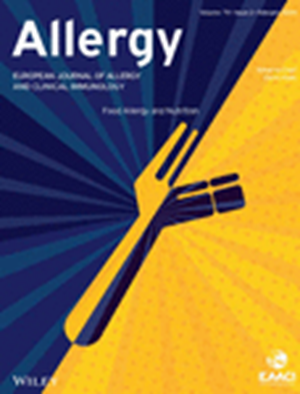Elevated Cutaneous Interleukin‐21 Links Eczematous Eruption to Interleukin‐17A Inhibitor Treatment in Psoriasis
IF 12
1区 医学
Q1 ALLERGY
引用次数: 0
Abstract
BackgroundEczematous eruption (EE) is an adverse effect observed in psoriasis patients undergoing interleukin (IL)‐17A inhibitor therapy, with reported incidence rates ranging from 2.2% to 12.1%. In some cases, this reaction leads to discontinuation of treatment. However, the underlying mechanism of EE development remains unclear. Therefore, we aimed to elucidate the pathogenesis of EE associated with anti‐IL‐17A treatment and identify pathogenic molecules involved.MethodsSkin samples were collected from psoriasis patients both before and after anti‐IL‐17A treatment, and the treated skin included those with and without EE. Transcriptomic profiling was performed using bulk RNA‐seq and scRNA‐seq, which were further validated by histopathological analysis and protein assay. In addition, in vitro experiments were conducted to explore the underlying mechanisms.ResultsBulk RNA‐seq analysis revealed significantly elevated IL‐21 expression in EE lesions, along with marked enrichment of Th2/Th22 pathways and activation of JAK–STAT signaling compared to baseline and non‐EE samples. Immunohistochemistry confirmed increased expression of IL‐21, pJAK1, and pSTAT3 in EE lesions. ELISA and LEGENDplex assays detected higher levels of IL‐21, IL‐13, and IL‐22, with positive correlations between IL‐21 and the latter two cytokines. ScRNA‐seq localized IL‐21 expression predominantly to T cells within EE lesions, which co‐expressed high levels of IL‐13 and IL‐22. In vitro, rhIL‐21 stimulation activated JAK1/STAT3 signaling and increased IL‐13 and IL‐22 secretion, which were suppressed by JAK1 inhibition. These findings identify IL‐21 as an important regulator of Th2/Th22 responses and JAK–STAT signaling in EE pathogenesis.ConclusionIL‐21 is an important inflammatory mediator contributing to the development of EE.皮肤白介素- 21升高与银屑病白介素- 17A抑制剂治疗有关
背景:湿疹性皮疹(EE)是银屑病患者在接受白细胞介素(IL)‐17A抑制剂治疗时观察到的一种不良反应,报道的发病率从2.2%到12.1%不等。在某些情况下,这种反应导致停止治疗。然而,情感表达发展的潜在机制尚不清楚。因此,我们旨在阐明与抗IL - 17A治疗相关的EE发病机制,并确定相关的致病分子。方法采集银屑病患者抗IL - 17A治疗前后的皮肤样本,包括EE患者和非EE患者。使用bulk RNA - seq和scRNA - seq进行转录组学分析,并通过组织病理学分析和蛋白质分析进一步验证。并通过体外实验探讨其作用机制。结果大量RNA - seq分析显示,与基线和非EE样品相比,EE病变中IL - 21表达显著升高,Th2/Th22通路显著富集,JAK-STAT信号通路激活。免疫组织化学证实,EE病变中IL - 21、pJAK1和pSTAT3的表达增加。ELISA和LEGENDplex检测检测到较高水平的IL - 21、IL - 13和IL - 22, IL - 21与后两种细胞因子呈正相关。ScRNA - seq将IL - 21的表达主要定位在EE病变内的T细胞上,这些细胞共同表达高水平的IL - 13和IL - 22。在体外,rhIL‐21刺激激活了JAK1/STAT3信号通路,增加了IL‐13和IL‐22的分泌,这些分泌被JAK1抑制。这些发现表明IL - 21在EE发病过程中是Th2/Th22反应和JAK-STAT信号的重要调节因子。结论il - 21是促进EE发展的重要炎症介质。
本文章由计算机程序翻译,如有差异,请以英文原文为准。
求助全文
约1分钟内获得全文
求助全文
来源期刊

Allergy
医学-过敏
CiteScore
26.10
自引率
9.70%
发文量
393
审稿时长
2 months
期刊介绍:
Allergy is an international and multidisciplinary journal that aims to advance, impact, and communicate all aspects of the discipline of Allergy/Immunology. It publishes original articles, reviews, position papers, guidelines, editorials, news and commentaries, letters to the editors, and correspondences. The journal accepts articles based on their scientific merit and quality.
Allergy seeks to maintain contact between basic and clinical Allergy/Immunology and encourages contributions from contributors and readers from all countries. In addition to its publication, Allergy also provides abstracting and indexing information. Some of the databases that include Allergy abstracts are Abstracts on Hygiene & Communicable Disease, Academic Search Alumni Edition, AgBiotech News & Information, AGRICOLA Database, Biological Abstracts, PubMed Dietary Supplement Subset, and Global Health, among others.
 求助内容:
求助内容: 应助结果提醒方式:
应助结果提醒方式:


